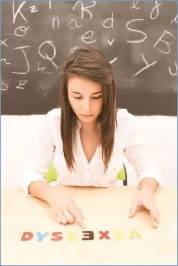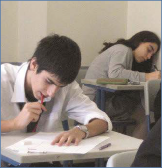< Previous | Contents | Next >
Learning Disabilities

A learning disability (LD) is any of a diverse group of conditions, of presumed neurological origin, that cause significant difficulties in auditory, visual, and/or spatial perception. Included are disorders that impair such functions as reading (dyslexia), writing (dysgraphia), and mathematical calculation (dyscalculia).
Each category exhibits a wide variation of behavioral patterns. In general, a variety of instructional modes enhance learning for LD students by allowing them to master material that may be inaccessible in one particular form. In other words, using multiple instructional techniques increases the likelihood that students with LD will succeed in college.
Functional Limitations
Memory and sequencing difficulties that may impede the students’ execution of complicated directions
Difficulty integrating information presented orally, hindering students’ ability to follow the sequence and organization of a lecture
Slow reading speed, which makes comprehension a difficulty for students with LD, particularly when dealing with large quantities of text
Difficulty taking notes caused by difficulty writing and assimilating, remembering, and organizing the material while listening to lectures
Difficulty talking, responding, or reading in front of groups, though many students with LD are highly articulate
Poor coordination, or trouble judging distance or differentiating between left and right
Problems during laboratory classes with new equipment, exact measurement, and multi-step procedures that may demand skills that are hard for LD students to acquire
Perceptual deficiencies that may cause students with LD to lack social skills or have difficulty sustaining focused attention

Accommodations
Priority Registration
Alternate location and/or extended time on exams
A less distracting environment for testing
Questions and directions read aloud for examinations
Substitute answer sheets, especially computer forms
Use of dictionary, calculator, computer spell checker, and proofreader
A note-taker, reader and/or scribe
Use of audio recorder or laptop computer in classroom
Course substitution for nonessential course requirements in the major
Extended time for in-class assignments to correct spelling, punctuation, and grammar
Alternative test format (e.g., large fonts, Braille, oral presentation, multiple choice in place of short essay questions, slide presentations, photographic essays, or hand-made models)
Teaching Strategies
State the day’s objectives at the beginning of the class
Paraphrase key points from the reading and lectures
Provide examples (and identify things that are not examples)
Provide written directions
Vary your teaching methods (lecture, discussion, small groups)
Provide step-by-step directions for class projects, bullet those directions, and give at least 2 weeks’ notice of due dates
Select well-organized textbooks with subheadings, clear explanations and instructions, and appropriate examples
Print out and/or digitize copies of overheads and make them available to students
Review material regularly
Encourage study groups
Provide pre-reading questions for each reading assignment or group of related assignments
Identify key points in the readings and lectures
Do not penalize students for spelling, organizational, or handwriting errors on timed examinations
Allow students to use laptop computers for essay exams if they prefer to do so
Provide written instructions for classwork and assignments, emphasizing exactly what you want students to do, and go over the instructions orally in class
Write out the stages students need to follow to complete an assignment
Provide adequate time for students to complete an assignment. Two weeks is good for a standard college paper; four weeks is the minimum for a paper requiring library research
Teach students to brainstorm and organize ideas. In most cases, informal outlines are more helpful than formal outlines because the latter can seem so detailed and formulaic that many students fail to do them or spend most of the time allocated working on the perfect outline and never complete the paper
Read drafts and give students written and oral feedback
Encourage students to read their work out loud, use tape recorders to record their brainstorming, and/or record an oral draft of their papers. Some voice recognition software is both affordable and user-friendly, so students who find this method helpful might consider exploring this type of software
Encourage the use of computers at all stages of the learning process.
Encourage students to attend regular tutoring sessions, and encourage tutors to focus on organization
Our Sources and Additional Resources:
National Center for Learning Disabilities:
http://www.ncld.org/parents-child-disabilities/teens/planning-college-success-for-students-with-learning-disabilities
Center for Universal Design in Instruction:
http://www.washington.edu/doit/CUDE/
Applying Universal Design for Instruction to online and blended courses:
http://www.cped.uconn.edu/udi-online.html
Access to post-secondary education through Universal Design learning (Colorado State University):
http://accessproject.colostate.edu/udl/
Awareness of Chronic Health Conditions (New Brunswick Department of Education):
http://www.gnb.ca/0000/publications/curric/awarchronichealth.pdf
Pedagogical strategies for teachers of Learning Disabled students:
http://www.users.drew.edu/~sjamieso/LDpedagogy.htm
< Previous | Contents | Next >


